Lunar Meteorite: Dhofar 303 and pairs
The Dhofar 303 clan consists of paired stones Dhofar 303, 305, 306, 307, 309, 310, 311, 489, 730, 731, 908, 909, 911, 950, 1085, & 2047

Slices of Dhofar stones 303, 305, 306, 309, 911 (2x), and 1085, with millimeter ticks for scale. The gray areas are veins of impact-melt glass that has the same composition as the pink clasts. The clasts are pink from hematite staining (terrestrial weathering). Photo credit: Randy Korotev

Slice of Dhofar 305. Photo credit: Randy Korotev
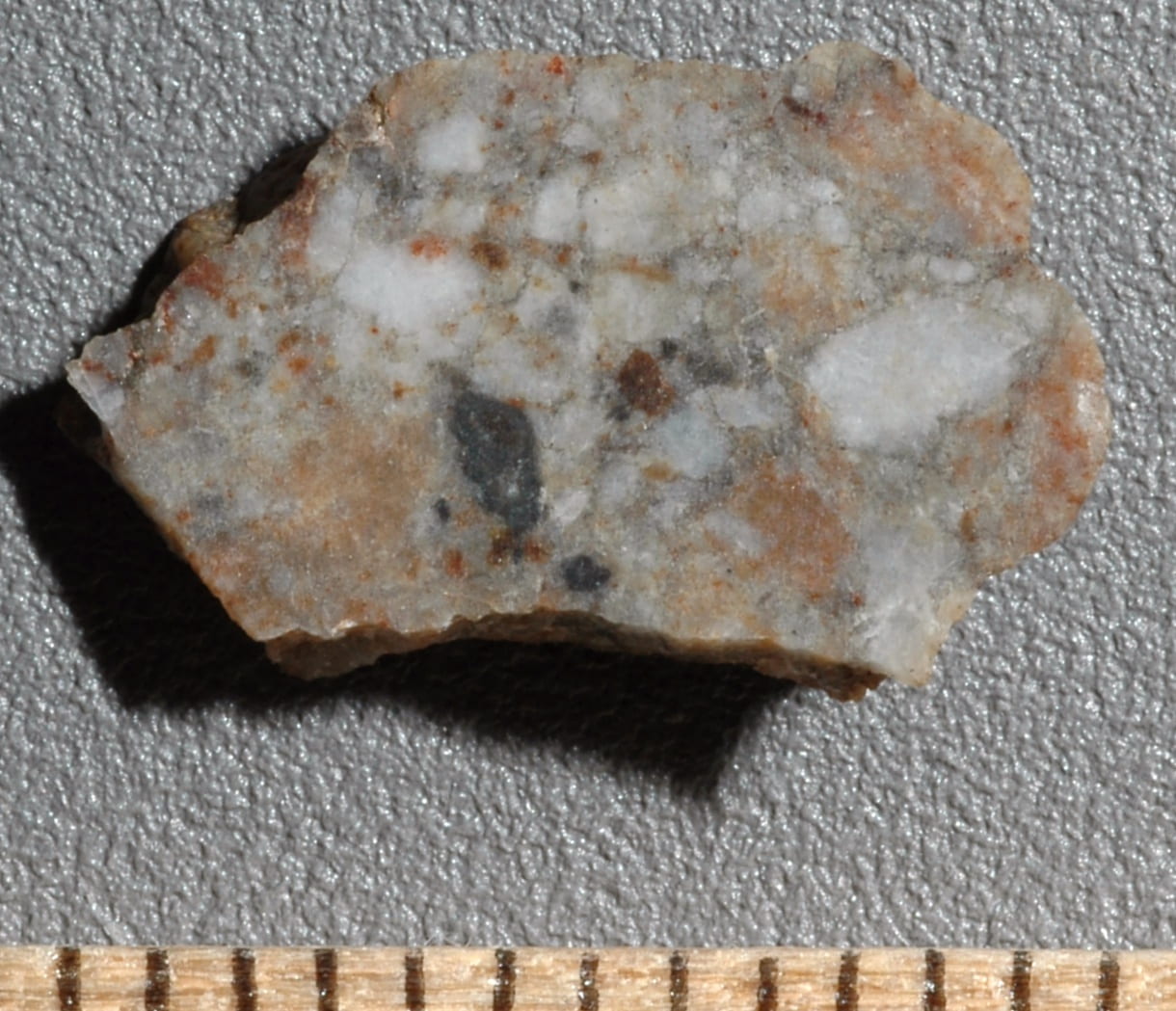
Slice of Dhofar 310. Photo credit: Randy Korotev
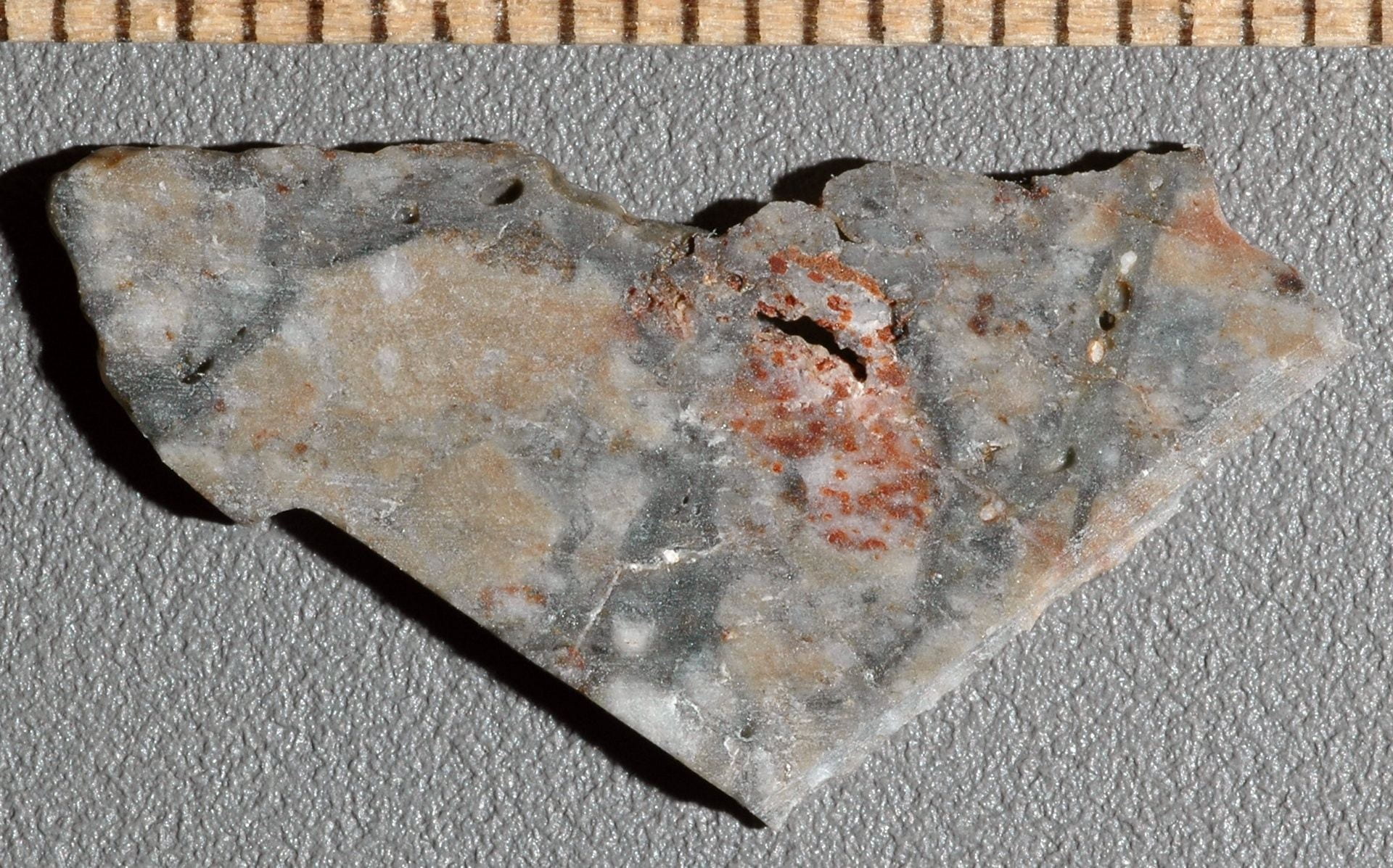
Slice of Dhofar 489. Note how the rounded vesicles are restricted to the glassy veins of impact melt (gray). Photo credit: Randy Korotev
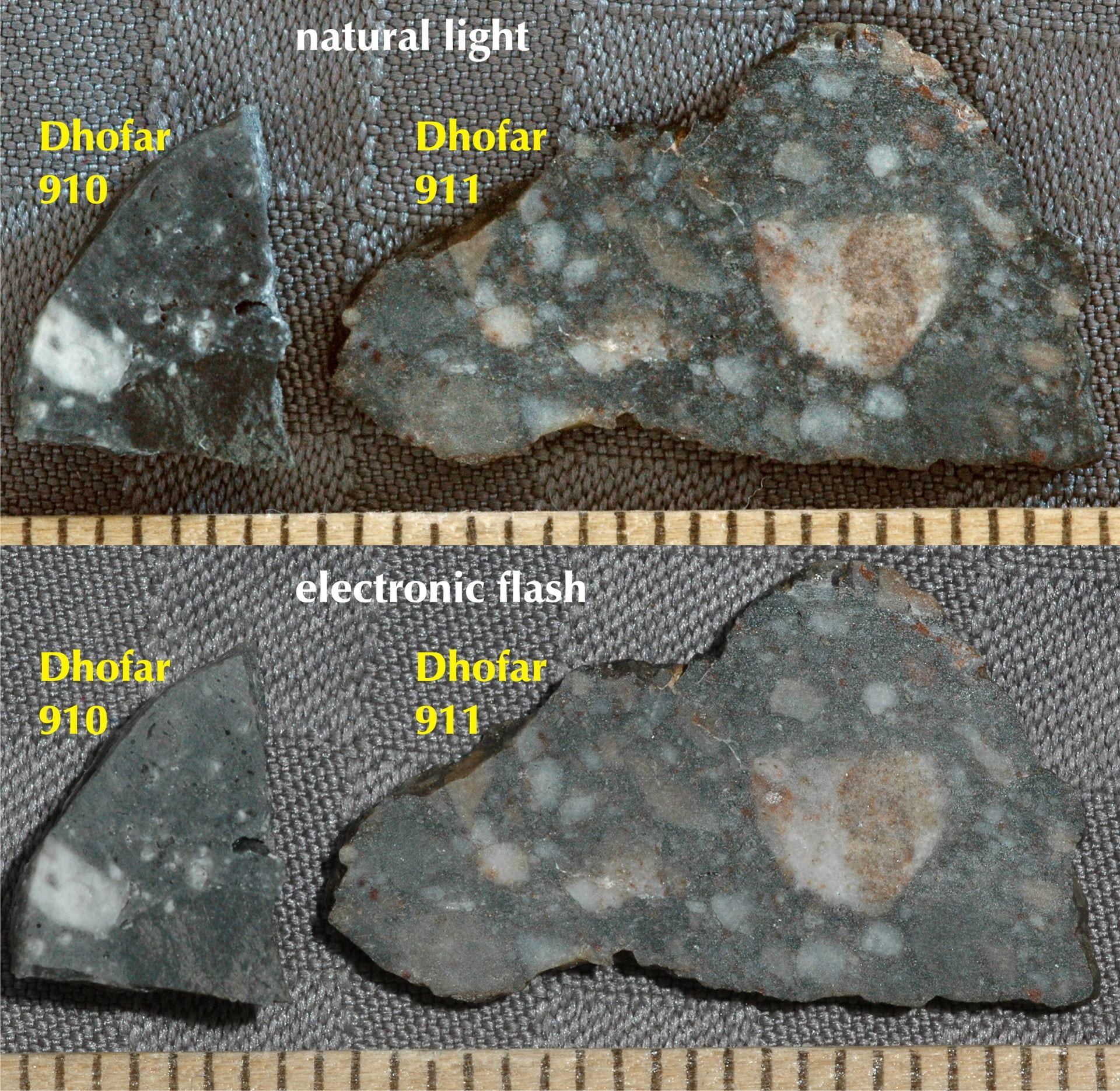
Comparison of a slice of Dhofar 910 with a dark slice of Dhofar 911. The Dhofar 081/280/910 pairs have no hematite staining (reddish) and are full of vesicles. All the Dhofar 303-clan stones have hematite staining and are rarely vesicular. The consecutive sample numbers only mean that they were submitted for classification about the same time. Photo credit: Randy Korotev

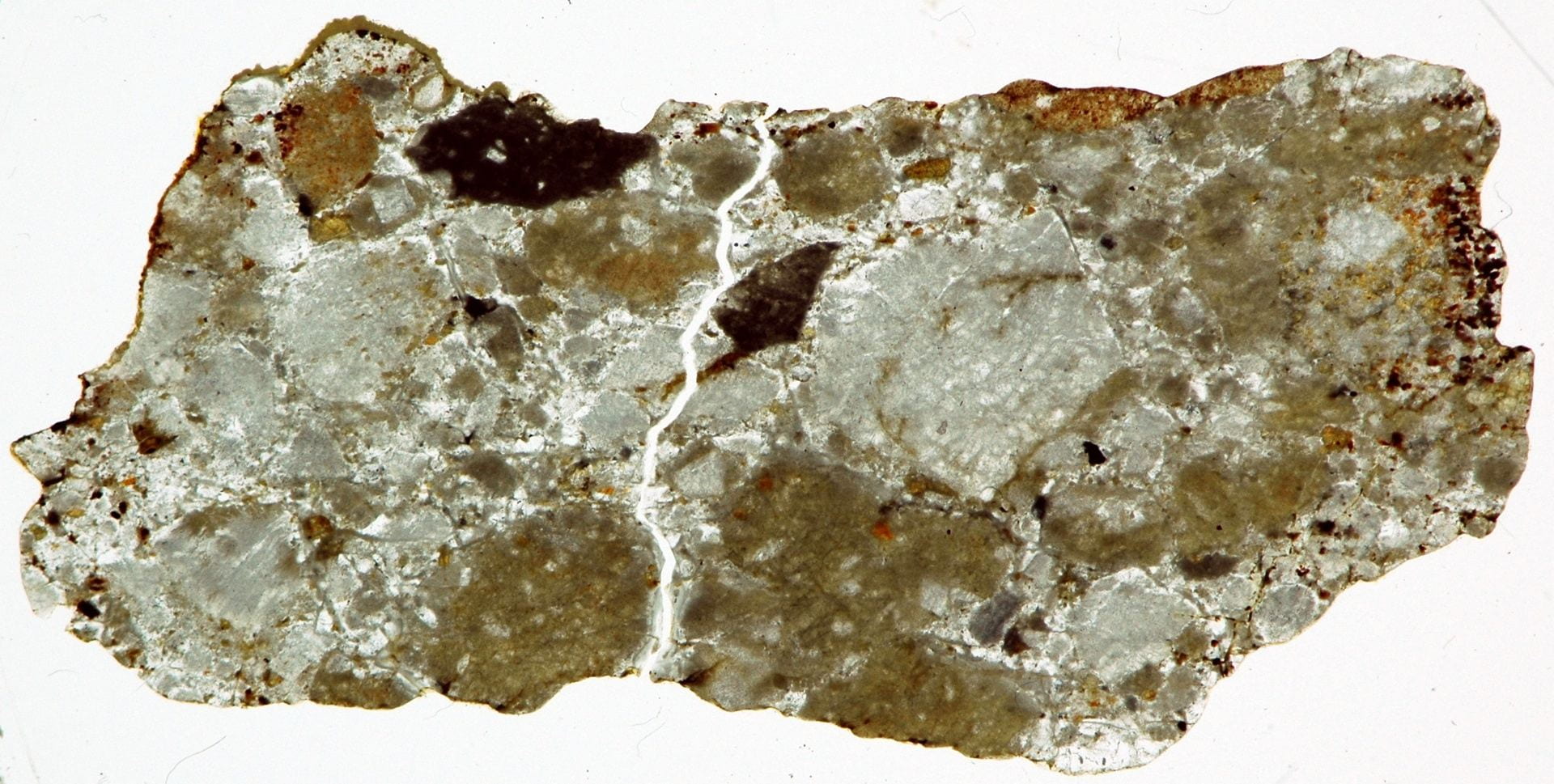
A different sawn slice of Dhofar 911 (above) and image of a thick (100 µm) section prepared from the slice (below). Width: 21 mm. Photo credit: Randy Korotev

Dhofar 1085 in the field. Photo credit: Siegfried Beutel
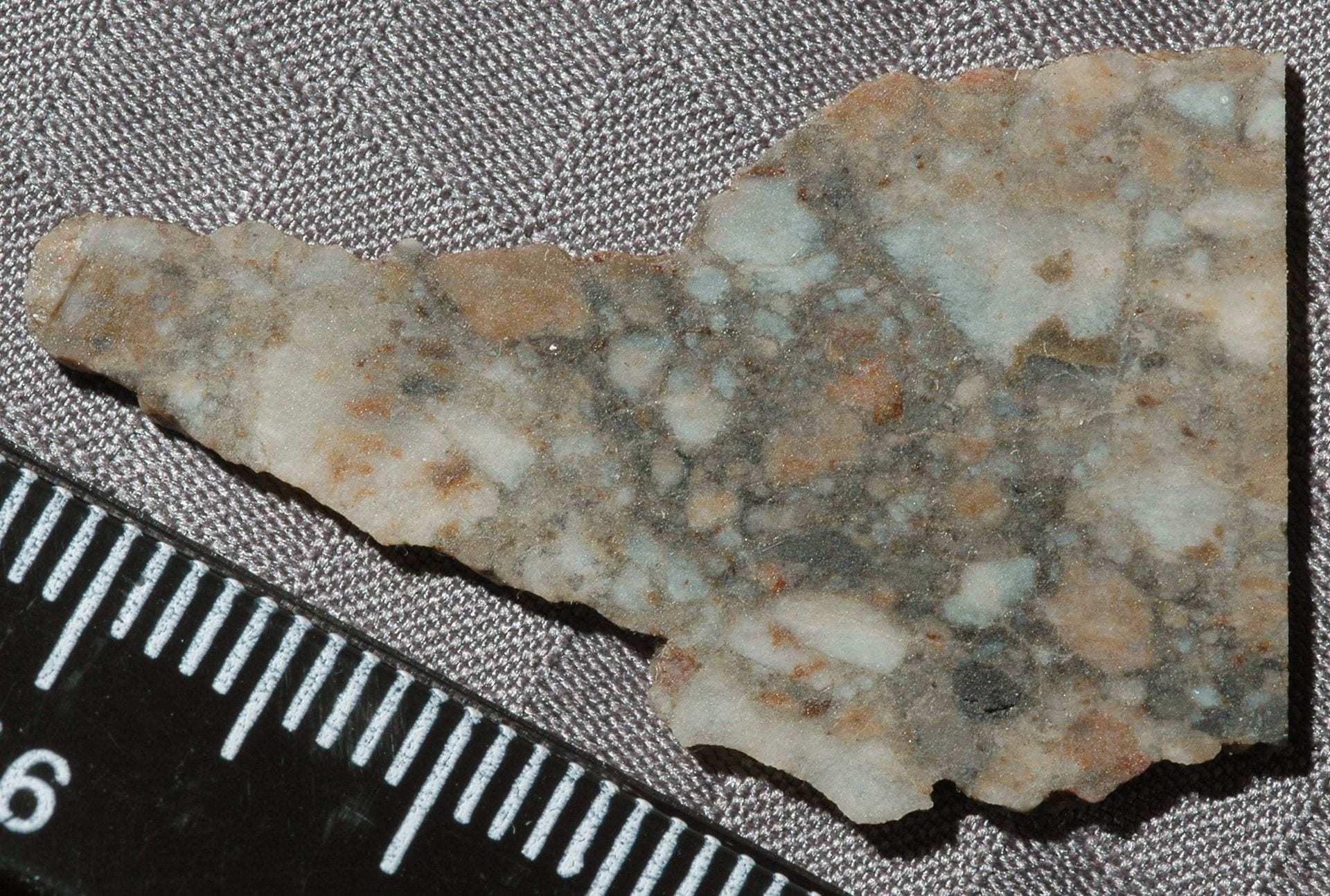
A sawn slice of Dhofar 1085. Photo credit: Randy Korotev

Dhofar 2047 in the field. Photo credit: anonymous finder

Sawn face of Dhofar 2047. Photo credit: Randy Korotev
|
from The Meteoritical Bulletin, No. 86 Dhofar 303Oman Lunar meteorite (anorthositic impact melt conglomerate) A light grey stone weighting 4.15 g was found in the Dhofar region of Oman. Mineralogy and classification (M. Nazarov, Vernad; L. Taylor, UTenn): fusion crust is absent; meteorite has a typical conglomerate texture; rounded lithic clasts are cemented by a very fine-grained impact melt matrix; clasts of impact melt breccias are most abundant and show commonly breccia-in-breccia textures; primary igneous rocks and granulites are rare and have mainly anorthositic and troctolitic compositions; feldspar, An94-99; orthopyroxene, Wo1-5En19-89; clinopyroxene, Wo6-46En29-70; olivine, Fo48-88 (Fe/Mn ~87 atom%); accessory minerals are Ti-rich chromite, ilmenite (3-6 wt% MgO), Al-Cr-Zr-rich armalcolite, rutile, troilite, and FeNi metal (1-37 wt% Ni; 0.2-2.3 wt% Co); composition of the impact melt matrix is SiO2 = 44.0, TiO2 = 0.15, Al2O3 = 29.8, Cr2O3 = 0.06, FeO = 3.17, MnO = 0.06, MgO = 4.91, CaO = 17.0, Na2O = 0.34, K2O = 0.01, P2O5 = 0.03 (wt%); the stone is moderately weathered; celestite, barite, gypsum, calcite and Fe hydroxides are present. The conglomerate texture and degree of weathering distinguish Dhofar 303 from Dhofar 302 and Dhofar 081/280, which were found nearby. However the meteorites may be paired. Specimens: type specimen, 0.85 g plus a thin section, Vernad; main mass with anonymous finder. |
|
from The Meteoritical Bulletin, No. 87 Dhofar 305Oman Lunar meteorite (anorthositic impact melt breccia) A light-grey stone weighing 34.11 g was found in the Dhofar region of Oman. Mineralogy and classification (M. Nazarov, Vernad, L. Taylor, UTenn): fusion crust is absent; the meteorite is an impact melt breccia consisting of mineral fragments and lithic clasts set within fine-grained, well-crystallized impact-melt matrix; clasts of impact melt breccias are most common; granulites and possible igneous rocks are rare and have mainly anorthositic and troctolitic compositions; orthopyroxenite clasts are present; feldspar, An87-98; orthopyroxene, Wo1-5En40-88; clinopyroxene; Wo6-48En30-70; olivine, Fo44-90 (Fe/Mn = 94 at); accessory minerals are Ti-rich chromite, Cr-pleonaste, ilmenite (1-8 wt % MgO), armalcolite, troilite, and FeNi metal (17-32 wt% Ni; 1.3-2.3 wt% Co); composition of the impact-melt matrix is (wt%) SiO2 = 43.9, TiO2 = 0.16, Al2O3 = 28.5, Cr2O3 = 0.10, FeO = 3.69, MnO = 0.07, MgO = 6.08, CaO = 15.9, Na2O = 0.36, K2O = 0.02, P2O5 = 0.04 (wt%); the stone is moderately weathered; calcite, celestite, gypsum, and Fe hydroxides are present. Dhofar 305 is close to Dhofar 303, which was found nearby, in degree of weathering, mineral chemistry, and matrix composition. The meteorites may be paired but they are very different in texture. Pairing with Dhofar 081/280, 302, 306 and 307 is also possible. Specimens: type specimens of 7 g, and a thin section, Vernad; main mass with anonymous finder. |
|
from The Meteoritical Bulletin, No. 87 Dhofar 306Oman Lunar meteorite (anorthositic impact melt breccia) A light-grey stone weighing 12.86 g was found in the Dhofar region of Oman. Mineralogy and classification (M. Nazarov, Vernad, L. Taylor, UTenn): fusion crust is absent; the meteorite is an impact melt breccia consisting from mineral fragments and lithic clasts cemented by fine-grained impact-melt matrix; clast population is dominated by impact melt breccias; granulites and cataclastic igneous rocks of anorthositic, troctolitic and noritic compositions are present; devitrified glass fragments occur also; a characteristic feature of the lithic clast population is abundant high mg# lithologies; feldspar, An93-98; orthopyroxene, Wo1-5En50-90; clinopyroxene; Wo10- 48En30-75, olivine, Fo48-94 (Fe/Mn = 87 at); accessory minerals are Ti-rich chromite, Cr-pleonaste, ilmenite (3-8 wt% MgO), armalcolite, silica, Ca-phosphate, troilite, and FeNi metal (7-68 wt% Ni, 0.3-3.4 wt% Co); composition of the impact-melt matrix is SiO2 = 44.0, TiO2 = 0.15, Al2O3 = 27.2, Cr2O3 = 0.12, FeO = 4.00, MnO = 0.05, MgO = 7.55, CaO = 15.5, Na2O = 0.33, K2O = 0.04, P2O5 = 0.07 (wt%); the stone is moderately weathered; celestite, calcite and Fe hydroxides are present. Dhofar 306 is different in texture and mineral chemistry from Dhofar 081/280, 302, 303, 305 and 307, which were found nearby. However the meteorites may be paired. Specimens: type specimen, 2.6 g and a thin section, Vernad; main mass with anonymous finder. |
|
from The Meteoritical Bulletin, No. 87 Dhofar 307Oman Lunar meteorite (anorthositic impact melt breccia) A light-grey stone weighing 50 g was found in the Dhofar region of Oman. Mineralogy and classification (M. Nazarov, Vernad, L. Taylor, UTenn): fusion crust is absent; the meteorite is an impact melt breccia; fine-grained impact melt is most abundant; mineral fragments and rare lithic clasts of anorthositic, troctolitic, and gabbro- noritic compositions occur in the impact-melt matrix; the presence of rare dunite fragments is a characteristic feature of the meteorite; glass veins are common; feldspar, An89-98; orthopyroxene, Wo1-5En50- 90; clinopyroxene; Wo6-48En40-75;, olivine, Fo38-94 (Fe/Mn = 92 at); accessory minerals are Ti-rich chromite, Cr-pleonaste, ilmenite (2-6 wt % MgO), troilite, and FeNi metal (8-49 wt% Ni, 0.3-2.0 wt% Co); composition of the glass veins is SiO2 = 43.8, TiO2 = 0.09, Al2O3 = 30.8, Cr2O3 = 0.09, FeO = 2.58, MnO = 0.05, MgO = 4.06, CaO = 17.3, Na2O = 0.36, K2O = 0.01, P2O5 = 0.02 (wt%); the stone is moderately weathered; calcite, gypsum, celestite, barite, and Fe hydroxides are present. Dhofar 307 is most similar in texture and mineral chemistry to Dhofar 305, found nearby. The meteorites are likely to be paired. Pairing with Dhofar 081/280, 302, 303, and 306 is also possible. Specimens: type specimen, 10 g and a thin section, Vernad; main mass with anonymous finder. |
|
from The Meteoritical Bulletin, No. 87 Dhofar 309Oman Lunar meteorite (anorthositic impact melt breccia) A grey, partly fusion-crusted 81.3 g stone was found in the Dhofar region of Oman. Classification and mineralogy (S. Demidova, Vernad; G. Kurat, NHMV): the meteorite is a clast-poor impact melt breccia; mineral fragments and lithic clasts are embedded in a matrix of devitrified glass. The clast population is dominated by granulite clasts of mainly anorthositic and troctolitic composition; fragments of possible pristine rocks and single mineral fragments are less common. Mineral compositions: plagioclase An93-98Or0.1-0.4; olivine Fo75-89 (atomic Fe/Mn ~79); orthopyroxene En80-86Wo2-5; clinopyroxene En46-82Wo5-46; accessory minerals are Ti-poor chromite and Cr-pleonaste, ilmenite (4-9 wt% MgO), troilite, and FeNi metal. The composition (wt%) of the impact melt matrix is MgO 6.2, CaO 16.1, Al2O3 29.1, SiO2 44.3, FeO 3.1; terrestrial weathering is not significant, although celestite and calcite are present in cracks. Dhofar 309 is different in texture and mineral chemistry from Dhofar 081/280, 302, 303, 305, 306, 310 found nearby. However, the meteorites may be paired. Specimens: 16.5 g plus two thin sections, Vernad; main mass with anonymous finder. |
|
from The Meteoritical Bulletin, No. 87 Dhofar 310Oman Lunar meteorite (anorthositic impact melt breccia) A grey 10.8 g stone was found in the Dhofar region of Oman. Classification and mineralogy (S. Demidova, Vernad; G. Kurat, NHMV): fusion crust is almost absent; the meteorite is a fragmental regolith breccia containing numerous mineral fragments and clasts of feldspathic rocks embedded in a devitrified glassy matrix; clasts of granulites and possible igneous rocks are abundant and have mainly anorthositic and troctolitic-noritic compositions, impact melt breccias and pyroxenitic clasts are also present; plagioclase An96-99Or0.1-0.2; olivine Fo44-86 (atomic Fe/Mn ~79); orthopyroxene En59-88Wo1-5; clinopyroxene En33-77Wo5-47; accessory minerals are Ti-rich chromite, ulvöspinel, pleonaste, ilmenite (2-7 wt% MgO), armalcolite, silica, troilite, FeNi metal; composition of the impact melt matrix is MgO 4.8, CaO 18.5, Al2O3 29.1, SiO2 43.5, FeO 3.0 (wt%); the stone is moderately weathered: calcite and gypsum veins and celestite inclusions are present. Dhofar 310 was found closely to Dhofar 302, 303, 305, 306, 307, 081/280 and may be paired with some of these meteorites. Specimens: 2.5g plus a thin section, Vernad; main mass with anonymous finder. |
|
from The Meteoritical Bulletin, No. 87 Dhofar 311Oman Lunar meteorite (anorthositic impact melt breccia) A small light-grey stone weighing 4 g was found in the Dhofar region of Oman. Mineralogy and classification (S. Demidova, Vernad; L. Taylor, UTenn): fusion crust is absent; mineral fragments and rounded lithic clasts occur within a fine-grained to cryptocrystalline impact-melt matrix; the lithic clast population comprises impact melt breccias, as well as cataclastic granulitic and igneous rocks of anorthositic and troctolitic compositions; clasts of impact-melt breccias are most abundant and typically show breccia-in-breccia textures; feldspar, An95-98; orthopyroxene, Wo2-5En45-85; clinopyroxene; Wo6-45En40-74, olivine, Fo57-88 (Fe/Mn ~91 at); accessory minerals include: Cr-pleonaste, Al-chromite, troilite, and FeNi metal (3-27 wt% Ni; 0.2-1.9 wt% Co); the stone is moderately weathered; calcite, gypsum, celestite, barite, and Fe hydroxides are present. Dho 311 was found 25m from Dho 280, but the meteorites are very different in weathering grade and lithology. Dho 311 is most similar in texture and mineral chemistry to Dho 303 found nearby. The meteorites may be paired. Pairing with Dho 302, 305, 306, 307, 309, 310, 730 and 731 is also possible. Specimens: type specimen of 1.7 g plus a thin section, Vernad; main mass with anonymous finder. |
|
from The Meteoritical Bulletin, No. 86 Dhofar 489Oman Lunar meteorite (feldspathic crystalline matrix breccia) History: One 34.4 g stone was found in the Dhofar region of Oman. Mineralogy and classification (H. Takeda, Chiba, T. Ishii and M. Ohtsuki UTok): A feldspathic fragmental breccia consisting of clasts of various lithologies embedded into a fine-grained crystalline matrix (crystals up to 0.04 mm in length). Clasts include cataclastic feldspars up to 1.8 x 0.6 mm in size, plus dark fine-grained impact melt breccia 3.3 x 2.3 mm in size with feldspar fragments. Plagioclase compositions of An95-97 are within the range of lunar anorthites. Pyroxene crystals in plagioclase and crystalline matrix range from En75Fs21Wo4 to En85Fs10Wo5 with FeO/MnO (wt%) =57. Olivine: Fa15 to Fa24 with FeO/MnO (wt%) = 78. Fine Ca carbonate veins penetrate into the specimen. Unlike known lunar meteorites, this lunar rock is a feldspathic crystalline matrix breccia. The most Mg-rich pyroxene is more Mg-rich than those of common lunar regolith breccias and similar to those of 60019, an Apollo 16 breccia containing poikilitic clasts. This lunar meteorite differs from other known lunar meteorites from the Dhofar region, which are either feldspathic regolith breccias or fragmental breccias. Specimens: type specimen: 6 g, NSMT; 0.42 g plus two polished thin sections, Chiba; main mass with anonymous finder. |
|
from The Meteoritical Bulletin, No. 87 Dhofar 730Oman Lunar meteorite (anorthositic impact-melt breccia) A light-grey stone weighing 108 g was found in the Dhofar region of Oman. Mineralogy and classification (M. Nazarov, Vernad; L. Taylor, UTenn): fusion crust is absent; lithic clasts and mineral fragments set within a fine-grained impact-melt matrix; the lithic clast population is dominated by impact-melt breccias and cataclastic granulitic and igneous rocks of anorthositic and troctolitic compositions; rare dunite fragments are present; feldspar, An86-98; orthopyroxene, Wo2-4En56-85; clinopyroxene; Wo6-46En14-71; olivine, Fo55-92 (Fe/Mn ~86 at). Accessory minerals include: chromite, Cr pleonaste, armalcolite, ilmenite, silica, troilite, and FeNi metal (6-48 wt% Ni; 1-2.4 wt% Co); the stone is moderately weathered; calcite, gypsum, celestite, barite, and Fe hydroxides are present. The meteorite may be paired with Dho 302, 303, 305, 306, 307, 309, 310, 311 and 731 found nearby. Specimens: type specimens of 22 g, and a thin section, Vernad; main mass with anonymous finder. |
|
from The Meteoritical Bulletin, No. 87 Dhofar 731Oman Lunar meteorite (anorthositic impact melt breccia) A light-grey stone weighing 36 g was found in the Dhofar region of Oman. Mineralogy and classification (M. Nazarov, Vernad; L. Taylor, UTenn): fusion crust is absent; lithic clasts and mineral fragments occur within a fine-grained impact-melt matrix; the lithic clast population consists mainly of impact-melt breccias of anorthositic and troctolitic compositions; feldspar, An95-97; orthopyroxene, Wo2-5En53-85; clinopyroxene; Wo6-45En30-81, olivine, Fo52-87 (Fe/Mn ~84 at). Accessory minerals include: Cr-pleonaste, chromite, ilmenite, troilite and FeNi metal (0.5-66 wt% Ni; 0.2-2 wt% Co); Cr pleonast is most common; the stone is moderately weathered; calcite, gypsum, celestite, barite, smectite, and Fe hydroxides are present. Dho 731 may be paired with Dho 302, 303, 305, 306, 307, 309, 310, 311, and 730. Specimens: type specimens of 7.5 g, and a thin section, Vernad; main mass with anonymous finder. |
|
from The Meteoritical Bulletin, No. 88 (Table 5) Dhofar 908, 909, 911, & 1085
|
|
from The Meteoritical Bulletin, No. 89 Dhofar 950Oman Lunar meteorite (feldspathic impact melt breccia) A grey stone weighing 21.7g was found in the Dhofar region of Oman. Mineralogy and classification (M. Nazarov, Vernad., Th. Ntaflos, University of Vienna): fusion crust is absent. The meteorite is an impact melt breccia with mineral fragments and lithic clasts cemented by a glassy impact melt matrix. The lithic clast population includes mainly granulitic rocks of anorthositic, troctolitic, gabbro-noritic and gabbro-anorthositic compositions. The sample contains abundant veins of glass. Mineral compositions are as follows: feldspar, An92-98Or0-0.3; orthopyroxene, Wo0.4-5En55-91; clinopyroxene; Wo5-44En30-72; olivine, Fo52-92 (Fe/Mn ˜ 85 at); accessory phases are Al-rich enstatite, Mg,Al-rich spinel, pleonaste, Al-rich chromite, ilmenite (1.1-8.5 wt.% MgO), armalcolite, silica, troilite, and FeNi metal (0.6-8 wt.% Ni; 0.4-1.1 wt.% Co). Matrix glass composition (wt.%): SiO2 43.9, TiO2 0.05, Al2O3 33.1, FeO 1.08, MgO 1.77, CaO 18.6, Na2O 0.37. The stone contains moderately weathered gypsum, celestite, and Fe hydroxides. The meteorite may be paired with Dho 302, 303, 305, 306, 307, 309, 310, 311, 730, 731 found nearby. Specimens: type specimens of 4.8g and a thin section, Vernad. The main mass is held by an anonymous finder. |
|
from The Meteoritical Bulletin, No. 105 Dhofar 2047Oman Lunar meteorite (feldspathic breccia) History: Found by a prospector. Physical characteristics: Fusion crust is absent. Petrography: Brecciated. Plagioclase is stained pink from hematite. No petrography in thin section was carried out because of the small stone mass. Geochemistry: Bulk composition (R. Korotev, WUSL) INAA of subsamples gave the following mean abundances (in wt.%) FeO 3.1, Na2O 0.35; (in ppm) Sc 4.6, La 0.8, Sm 0.33, Eu 0.74, Yb 0.26, Lu 0.040, Th 0.09. Classification: Lunar (feldspathic breccia). The stone is indistinguishable in lithophile element composition from Dhofar 303, 305, 306, 309, 310, 908, 911, and 1085 and was found 0.7-1.6 km away from these. Specimens: 1.14 g at UAb. |
|
Randy Says… The Dhofar 303 clan is unique among lunar meteorites in being highly feldspathic (~28% Al2O3), troctolitic (~Fo78), and low in KREEP elements (0.3-0.4 ppm Sm). |
More InformationMeteoritical Bulletin Database Dhofar 303 | 305 | 306 | 307 | 309 | 310 | 311 | 489 | 730 | 731 | 908 | 909 | 911 | 950 | 1085 | 2047 Map Schematic Map of the Find Locations of the Dhofar Lunar Meteorites Arai T. (2008) Magnesian anorthosite: A new class of lunar crustal rock and implication for crustal genesis. Workshop on Antarctic Meteorites: Search, Recovery, and Classification. Meteoritics & Planetary Science 43, A179. Arai T., Takeda H., Yamaguchi A., and Ohtake (2007) Lithology of lunar farside crust. 70th Annual Meeting of the Meteoritical Society, abstract no. 5167. Arai T., Takeda H., Yamaguchi A., and Ohtake M. (2007) Dhofar 489 et al. as ground truth of the lunar farside crust. Antarctic Meteorites XXXI, 3-4. Arai T., Takeda H., Yamaguchi A., and Ohtake M. (2008) A new model of lunar crust: asymmetry in crustal composition and evolution. Earth, Planets and Space, 60, 433-444. Arai T., Saiki K., Ohtake M., Matsunaga T., Ogawa Y., Nakamura R., and LISM Working Group (2008) Origin of lunar troctolite: Implication for composition and crystallization of magma ocean. 71st Annual Meeting of the Meteoritical Society, abstract no. 5326 Arai T., Yamamoto A., Ohtake M., Matsunaga T., Haruyama J., Hiroi T., Sasaki S., and Matsui T. (2011) Lunar crustal mineralogy inferred from lunar meteorites and Kaguya data. The 34rd Symposium on Antarctic Meteorites, 3-4. Arai T., Hiroi T., Sasaki S., and Matsui T. (2013) Origin of the lunar crust inferred from mineralogy and reflectance spectra of lunar meteorites. 44th Lunar and Planetary Science Conference, abstract no. 1016. Cohen B. A. (2005) More impact-melt clasts in feldspathic lunar meteorites. 68th Annual Meeting of the Meteoritical Society, abstract no. 5314. Cohen B. A. (2008) Lunar meteorite impact melt clasts and lessons learned for lunar surface sampling. Lunar and Planetary Science XXXIX, abstract no. 2532, 39th Lunar and Planetary Science Conference. Demidova S. I., Nazarov M. A., Taylor L. A., and Patchen A. (2003) Dhofar 304, 305, 306 and 307: New lunar highland meteorites from Oman. Lunar and Planetary Science 34, abstract no. 1285. Demidova S. I., Nazarov M. A., Lorenz C. A., Kurat G., Brandstätter F., and Ntaflos Th. (2007) Chemical composition of lunar meteorites and the lunar crust. Petrology 15 (4), 386-407. Fernandes V. A., Anand M., Burgess R., and Taylor L. A. (2004) Ar-Ar studies of Dhofar clast-rich feldspathic highland meteorites: 025, 026, 280, 303. Lunar and Planetary Science XXXV, abstract no. 1514. Fritz J. (2012) Impact ejection of lunar meteorites and the age of Giordano Bruno. Icarus 221, 1183-1186. Fu X. H., Hou X. T., Cao H. J., Chen J., and Ling Z. C. (2020) Mineralogy and geochemistry of lunar magnesian breccia Dhofar 1085. 51st Lunar and Planetary Science Conference, abstract no. 1758. Gu X., Chen J., Cao H., Ling Z., and X. Fu (2019) Petrography and mineralogy of lunar fragmental breccia Dhofar 910. 50th Lunar and Planetary Science Conference, abstract no. 2367. Hidaka H. and Yoneda S. (2006) Neodymium, samarium and gadolinium isotopic studies of lunar meteorites Dhofar 489 and NWA 032. 69th Annual Meeting of the Meteoritical Society, abstract no. 5169. Hidaka H. and Yoneda S. (2013) Isotopic studies of radiogenic and neutron-captured REE of lunar meteorites. 76th Annual Meeting of the Meteoritical Society, abstract no. 5042. Hidaka H., Nishiizumi K., Caffee M., and Yoneda S. (2019) Samarium isotopic compositions of lunar meteorites. 82nd Annual Meeting of the Meteoritical Society, abstract no. 6279. Karouji Y., Ebihara M., and Yamaguchi A. (2004) Chemical characterization of lunar meteorites, Yamato 86032 and Dhofar 489. Antarctic Meteorites XXVIII, 29-30. Karouji Y., Takeda H., Nyquist L. E., Bogard D. D., and Ebihara M. (2010) Geochemical and mineralogical comparisons of the Dhofar 489 and Y-86032 group lunar meteorites with reference to recent remote sensing data. 33rd Symposium on Antarctic Meteorites. Korochantseva E. V., Buikin A. I., Hopp J., Korochantsev A. V., and Trieloff M. (2016) 40Ar-39Ar results of lunar meteorites Dhofar 025, 280, 309, 730, 733, 1436, 1442, SaU 449, NWA 6888. 79th Annual Meeting of the Meteoritical Society, abstract no. 6317. Korotev R. L. (2005) Lunar geochemistry as told by lunar meteorites. Chemie der Erde 65, 297-346. Korotev R. L. (2006) Geochemistry of a unique lunar meteorite from Oman, a crystalline impact-melt breccia dominated by magnesian anorthosite. Lunar and Planetary Science XXVII, abstract no. 1402. Korotev R. L. (2012) Lunar meteorites from Oman. Meteoritics & Planetary Science 47, 1365-1402. Korotev R. L. (2017) Update (2012–2017) on lunar meteorites from Oman. Meteoritics & Planetary Science 52, 1251-1256. All Korotev data on Omani lunar meteorites. Korotev R. L. and Irving A. J. (2017) Still not keeping up with the lunar meteorites – 2017. Lunar and Planetary Science XLVIII, abstract no. 1498. Korotev R. L., Zeigler R. A., and Jolliff B. L. (2006) Feldspathic lunar meteorites Pecora Escarpment 02007 and Dhofar 489: Contamination of the surface of the lunar highlands by post-basin impacts. Geochimica et Cosmochimica Acta 70, 5935-5956. Maloy A. K. and Treiman A. H. (2007) Magnesian anorthositic clasts in lunar meteorites ALHA 81005 and Dho 039 [sic]: Bulk compositions and regional significance. 70th Annual Meeting of the Meteoritical Society, abstract no. 5109. Miura Y. N. and Nagao K. (2004) Noble gases in the Dhofar 489 lunar meteorite. 67th Annual Meteoritical Society Meeting, abstract no. 5131. Nagaoka H., Takeda H., Karouji Y., Ohtake M., Yamaguchi A., Yoneda S., and Hasebe N. (2012) Comparisons of mineralogy of pure anorthosite in lunar meteorites, Dhofar 489 group and pure anorthosite observed by Kaguya. 75th Annual Meeting of the Meteoritical Society, abstract no. 5197. Nagaoka H., Takeda H., Karouji Y., Ohtake M., Yamaguchi A., Yoneda S., and Hasebe N. (2012) Comparisons of mineralogy of pure anorthosite in lunar meteorites, Dhofar 489 group and pure anorthosite observed by Kaguya. 75th Annual Meeting of the Meteoritical Society, abstract no. 5197. Nagaoka H., Takeda H., Karouji Y., Ohtake M., Yamaguchi A., Yoneda S., and Hasebe N. (2012) Implications for the origins of pure anorthosites found in the feldspathic lunar meteorites, Dhofar 489 group. Earth, Planets and Space 66, 115. Nazarov M. A., Demidova S. I., Patchen A., and Taylor L. A. (2002) Dhofar 301, 302 and 303: Three new lunar highland meteorites from Oman. Lunar and Planetary Science XXXIII, abstract no. 1293. Nazarov M. A., Demidova S. I., and Taylor L. A. (2003) Trace element chemistry of lunar highland meteorites from Oman. Lunar and Planetary Science XXXIV, abstract no. 1636. Nazarov M. A, Demidova S. I., Patchen A., and Taylor L. A. (2004) Dhofar 311, 730 and 731: New lunar meteorites from Oman. Lunar and Planetary Science XXXV, abstract no. 1233. Nazarov M. A., Badyukov D. D., Lorents K.A., Demidova. S. I. (2004) The flux of lunar meteorites onto the Earth. Solar System Research 38, 49-58. Nazarov M. A., Aranovich Ya., Demidova S. I., Ntaflos T., and Brandstätter F. (2011) Aluminous enstatites of lunar meteorites and deep-seated lunar rocks. Petrology 19, 13-25. Nishiizumi K. and Caffee M. W. (2006) Constraining the number of lunar and martian meteorite falls. 69th Annual Meeting of the Meteoritical Society, abstract no. 5368. Nishiizumi K., Hillegonds D. J., McHargue L. R., and Jull A. J. T. (2004) Exposure and terrestrial histories of new lunar and martian meteorites, In Lunar and Planetary Science XXXV, abstract no. 1130. Nyquist L. E., Shih C.-Y., Reese Y. D., Park J., Bogard D. D., Garrison D. H., and Yamaguchi A. (2010) Lunar crustal history recorded in lunar anorthosites. 41st Lunar and Planetary Science Conference, abstract no. 1383. Nyquist L. E., Shih C.-Y., Reese Y. D., Park J., Bogard D. D., Garrison D. H., Yamaguchi A., and Joy K. H. (2010) Implications for lunar crustal evolution from Y-86032 and Dho 908. 33rd Symposium on Antarctic Meteorites. Nyquist L. E., Shih C.-Y., Reese Y. D., Park J., Bogard D. D., Garrison D. H., and Yamaguchi A. (2011) Sm-Nd and Ar-Ar studies of Dho 908 and 489: Implications for lunar crustal history. 42nd Lunar and Planetary Science Conference, abstract no. 2368. Rochette P., Gattacceca J., Ivanov A. V., Nazarov M. A., and Bezaeva N. S. (2010) Magnetic properties of lunar materials: Meteorites, Luna and Apollo returned samples. Earth and Planetary Science Letters 292, 383-391. Russell S. S., Joy K. H., Jeffries T. E., Consolmagno G. J., and Kearsley A. (2014) Heterogeneity in lunar anorthosite meteorites: implications for the lunar magma ocean model. Philosophical Transactions of the Royal Society A 372: 20130241. http://dx.doi.org/10.1098/rsta.2013.0241 Shukolyukov, Y. A., Nazarov, M. A., Ott, U. (2004) Noble gases in new lunar meteorites from Oman: Irradiation history, trapped gases, and cosmic-ray exposure and K-Ar ages. Geochemistry International 42, 1001-1017. Takeda H., Saiki K., Ishii T., and Otsuki M. (2003) Mineralogy of the Dhofar 489 lunar meteorite, crystalline matrix breccia with magnesian anorthositic clasts. Lunar and Planetary Science XXXIV, abstract no. 1284. Takeda H., Bogard D. D., Yamaguchi A., Ohtake M., and Saiki K. (2004) A crustal rock clast in magnesian anorthositic breccia, Dhofar 489 and its excavation from a large basin. Lunar and Planetary Science XXXV, abstract no. 1222. Takeda A., Bischoff A., and Yamaguchi A. (2004) Magnesian granulitic clasts in some lunar meteorites from the feldspathic highlands. Antarctic Meteorites XXVIII, 83-84. Takeda H., Arai T., Yamaguchi A., and Mikouchi T. (2006) Important lithologies of the lunar farside crust: Coarse-grained granulites or magnesian anorthosites, In Lunar and Planetary Science XXXVII, abstract no. 1572. Takeda H., Yamaguchi A., Bogard D. D., Karouji Y., Ebihara M., Ohtake M., Saiki K. and Arai T. (2006) Magnesian anorthosites and a deep crustal rock from the farside crust of the moon. Earth and Planetary Science Letters 247, 171-184. Takeda H., Arai T., Yamaguchi A., Otuki M., and Ishii T. (2007) Mineralogy of Dhofar 309, 489 and Yamato-86032 and varieties of lithologies of the lunar farside crust. Lunar and Planetary Science XXXVIII, abstract no. 1607. Takeda H., Yazawa Y., Arai T., Yamaguchi A., Saito M., Ishii T., Otsuki M., and Kanamori H. (2007) Feldspathic lunar meteorites from the farsiude and production of their lunar simulants. Antarctic Meteorites XXXI, 95-96. Takeda H. Arai T. Yamaguchi A. Otsuki M. Ohtake M. (2008) Granulitic lithologies in Dhofar 307 lunar meteorite and magnesian, Th-poor terrane of the northern farside crust. Lunar and Planetary Science XXXIX, abstract no. 1574. Takeda H., Karouji Y., Ogawa Y., Otsuki M., Yamaguchi A., Ohtake M., Arai T., Matsunaga T., and Haruyama J. (2009) Iron contents of plagioclases in Dhofar 307 lunar meteorite and surface materials of the farside large basins. 40th Lunar and Planetary Science Conference, abstract no. 1565. Takeda H., Kobayashi S., Yamaguchi A., Otsuki M., Ohtake M., Haruyama J., Morota T., Karouji Y., Hasebe N., Nakamura R., Ogawa Y. and Matsunaga T. (2010) Olivine fragments in Dhofar 307 lunar meteorite and surface materials of the farside large basins. 41st Lunar and Planetary Science Conference, abstract no. 1572. Takeda H., Yamaguchi A., Otsuki M., Hiroi T., Ohtake M., and Kato M. (2010) Mineralogical interpretation on the feldspathic highlands of the Moon on the basis of some feldspathic lunar meteorites. 73rd Annual Meeting of the Meteoritical Society, abstract no. 5060. Takeda H., Nagaoka H., Ohtake M., Kobayashi S., Yamaguchi A., Morota T., Karouji Y., Haruyama J., Katou M., Hiroi T., Nyquist L. E. (2012) Comparisons of mineralogy of lunar meteorites possibly from the farside and the Kaguya remote sensing data to reconstruct the earliest anorthositic crust of the Moon. 43rdLunar and Planetary Science Conference, Abstract no. 1379. Takenouchi A. and Mikouchi T. (2016) Mineralogical study of reddish olivine in Dhofar 307 lunar meteorite: Comparison with brown olivine in martian meteorites. 79th Annual Meeting of the Meteoritical Society, abstract no. 6135. Treiman A. H., Maloy A. K., and Shearer C. K. Jr. (2008) Magnesian anorthositic granulite: An abundant, significant, and poorly understood lunar rock type of the lunar highlands. NLSI Lunar Science Conference, LPI Contribution No. 1415, abstract no. 2112. Treiman A. H., Maloy A. K., Shearer C. K. Jr., and Gross J. (2010) Magnesian anorthositic granulites in lunar meteorites Allan Hills A81005 and Dhofar 309: Geochemistry and global significance. Meteoritics & Planetary Science 45, 163-180. Wang Y., Guan Y., Hsu W., and Eiler J. M. (2012) Water content, chlorine and hydrogen isotope compositions of lunar apatite. 75th Annual Meeting of the Meteoritical Society, abstract no. 5170. Yokoi N., Takenouchi A., and Mikouchi T. (2018) Iron valence states of plagioclase in some lunar meteorites. 49th Lunar and Planetary Science Conference, abstract no. 2227. |